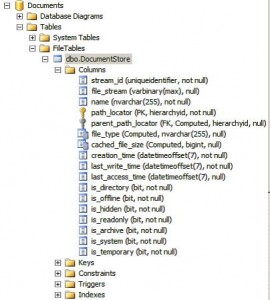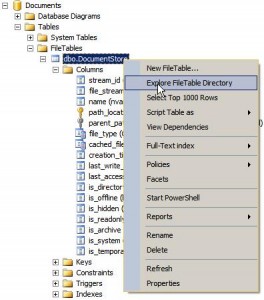What’s New in SQL Server 2012 -Part 1

Columnstore Index
Columnstore technology has introduced to SQL Server 2012 is the
columnstore index. This is an index created just like any other, but it stores index
data in a highly compressed, column-wise fashion. For certain classes of queries,
particularly those found in Kimball-design star schemas, columnstore indexes make
a lot of sense. Typical performance gains of between 10x – 100x performance can be
possible for certain queries, so they are worth investigating, as they may provide
an alternative to a very costly hardware upgrade.
CREATE TABLE Customer
(
CustomerName varchar(200) NULL,
DateOfBirth datetime NULL,
Sex char(10) NULL,
Salary int NULL,
LoanAmount int NULL
)
CREATE NONCLUSTERED COLUMNSTORE INDEX csidxCustomer
ON Customer (CustomerName, DateOfBirth, Sex, Salary, LoanAmount)
However, columnstore indexes do have some restrictions. The most limiting
restriction at present is that they cannot be updated, and as such any updates
applied to a table will fail. If you do try to perform an insert, update or delete,
you will see the following error message, even if the query affects zero rows:
INSERT statement failed because data cannot be updated in a table with
a columnstore index
IN SQL2014 we can use columnstore index DML operations also.
Update or insert will not fail
String functions
With SQL Server 2012 Microsoft has introduced two new string functions,
bringing the total to 25.
CONCAT
CONCAT is to perform a concatenation operation. Pass CONCAT a number of string arguments and it will concatenate, or join them together and return an output string.
CREATE TABLE #Customer
(
FirstName varchar(30) NOT NULL,
MiddleName varchar(30) NULL,
LastName varchar(30) NOT NULL
)
INSERT INTO #Customer
VALUES (‚Rachel‘, ‚Jane‘, ‚Clements‘), (‚Jon‘, NULL, ‚Reade‘)
SELECT CONCAT(FirstName + ‚ ‚, MiddleName + ‚ ‚, LastName) AS
CustomerName
FROM #Customer
SELECT FirstName + ‚ ‚ + MiddleName + ‚ ‚ + LastName AS CustomerName
FROM #Customer
Using the CONCAT function we can return a concatenation of values,
allowing for NULL values
FORMAT
Syntax:
FORMAT ( value, format [, culture ] )
The first parameter (value) is the variable to apply the formatting to. The second
argument, format, is the format of the value. Take care with the format argument,
as this must be a supported .NET Framework format. Culture is the locale you would
like to apply to the value. If you choose not to supply a culture, the function will
use that of the current session.
DECLARE @MyDate datetime = ’10/08/2012′
SELECT FORMAT(@MyDate, ‚dd/mm/yyyy‘, ‚en-US‘) AS NewDate
Datetime functions
EOMONTH
This function does exactly what it says, returning the last day
of the month you specify.
DECLARE @MyDate datetime
SET @MyDate = ’05/17/2012′
SELECT EOMONTH (@MyDate) AS LastDayOfTheMonth
There is another parameter value you can feed in to return the end
of the month, either in the past or future
DECLARE @MyDatedatetime DATETIME
SET @MyDatedatetime = ’05/17/2012′
SELECT EOMONTH (@MyDatedatetime, 6) AS LastDayOfTheMonth
By utilizing a negative number, we can go back six months
DECLARE @MyDate datetime
SET @MyDate = ’05/17/2012′
SELECT EOMONTH (@MyDate, -6) AS LastDayOfTheMonth
DATEFROMPARTS
Next up is the DATEFROMPARTS function which accepts year, month and day
parameters and returns them as a date variable
In SQL 2008 and below version we can write like this:
DECLARE @Year int, @Month int, @Day int
SET @Year = 2012
SET @Month = 04
SET @Day = 09
SELECT CONVERT(datetime,CONVERT(varchar(10),@Year) + ‚/‘ +
CONVERT(varchar(10),@Month) + ‚/‘ +
CONVERT(varchar(10),@Day),103) AS MyDate
We can write the above query as
DECLARE @Year int, @Month int, @Day int
SET @Year = 2012
SET @Month = 09
SET @Day = 23
SELECT DATEFROMPARTS (@Year, @Month, @Day) AS MyDate
TIMEFROMPARTS
The TIMEFROMPARTS function works in exactly the same way, but instead of
passing in the year, month and day, as you have probably guessed, you pass
in time parameters instead:
DECLARE @Hour int, @Minutes int, @Seconds int,
@FractionsOfASecond int
SET @Hour = 15
SET @Minutes = 23
SET @Seconds = 47
SET @FractionsOfASecond = 0
SELECT TIMEFROMPARTS (@Hour, @Minutes, @Seconds,@FractionsOfASecond, 2) AS MyTime
DATETIMEFROMPARTS
You can combine time and date with the DATETIMEFROMPARTS function and this
will return a datetime variable
DECLARE @Year int, @Month int, @Day int, @Hour int,
@Minutes int, @Seconds int, @MilliSeconds int
SET @Year = 2012
SET @Month = 07
SET @Day = 23
SET @Hour = 17
SET @Minutes = 27
SET @Seconds = 49
SET @MilliSeconds = 0
SELECT DATETIMEFROMPARTS (@Year, @Month, @Day, @Hour, @Minutes,
@Seconds, @MilliSeconds) AS MyDateTime
TRY_PARSE
Is a conversion function
SELECT TRY_PARSE (‚SQL Server 2012‘ AS datetime) AS MyDateTime
Will return null value
CREATE TABLE DataToBeCleansed
(
ID int IDENTITY (1,1),
IntegerDataToBeCleansed nvarchar(3)
)
GO
INSERT INTO DataToBeCleansed (IntegerDataToBeCleansed)
VALUES (‚1‘),
(‚2‘),
(‚E‘),
(‚4‘),
(‚5‘),
(‚6‘),
(‚L‘),
(‚8‘),
(‚9′),
(’10‘)
GO
SELECT ID, IntegerDataToBeCleansed
FROM DataToBeCleansed
WHERE TRY_PARSE(IntegerDataToBeCleansed AS int) IS NULL
SEQUENCE
A SEQUENCE object is created at the database level but, unlike an IDENTITY property,
it can be used across multiple tables. An IDENTITY value is generated when you
insert a row into a table and it cannot be updated. You can retrieve the SEQUENCE
value at any time and reset it without altering its previous value, and even set a
minimum and maximum value. Let us look at a simple example:
CREATE SEQUENCE mySequence AS int
START WITH 1
INCREMENT BY 1
CREATE TABLE Employee
(
EmployeeID int NOT NULL,
FirstName varchar(30) NOT NULL,
LastName varchar(30) NOT NULL
)
INSERT INTO Employee (EmployeeID, FirstName, LastName)
VALUES
(NEXT VALUE FOR mySequence, ‚Rachel‘, ‚Clements‘),
(NEXT VALUE FOR mySequence, ‚Jon‘, ‚Reade‘)
GO
Reset Sequence
ALTER SEQUENCE mySequence
RESTART WITH 1
If we wanted to set a minimum and maximum value we could have declared our
SEQUENCE as follows:
CREATE SEQUENCE mySequence1 AS int
START WITH 1
INCREMENT BY 1
MINVALUE 1
MAXVALUE 15
As you can see, mySequence is now available for use by all tables in the database:
We have not used the SEQUENCE object yet, so the first value returned should be 1.
Run the following statement to confirm this:
SELECT NEXT VALUE FOR mySequence AS [Next Value]
WITH RESULT SETS
The EXECUTE statement has been extended in SQL Server 2012 to include the WITH
RESULT SETS option. This allows you to change the column names and data types
of the result set returned in the execution of a stored procedure.
We will jump straight into an example to see how this works. The following
procedure returns a straightforward result set using the Employee table we
created in the previous section:
CREATE PROC spGet_Employees
AS
SELECT EmployeeID, FirstName, LastName
FROM Employee
ORDER BY EmployeeID
If we call this stored procedure in the usual way it will return all columns.
The data type of each column will be the same as the column type in the table.
EXEC spGet_Employees
In the previous section, we used the mySequence SEQUENCE object to set the value
that was inserted into the EmployeeID column. We want to return the result set
so the integer EmployeeID column is a varchar instead. To see how you can
easily change the name of the columns, we will output EmployeeID as NI_Number
and LastName as Surname. We can do this easily using
WITH RESULT SETS:
EXEC spGet_Employees
WITH RESULT SETS
(
(
NI_Number varchar(15),
FirstName varchar(30),
Surname varchar(30)
)
)
FileTable table type
FileTable is a new type of table which builds on the existing FILESTREAM
functionality that was introduced in SQL Server 2008. FILESTREAM is an efficient
way to store documents inside the database, as they are managed by SQL Server
and included in any backups. You can store any type of file and up to any size—the
only limit is the size of the disk the FILESTREAM store sits on.
FILESTREAM effectively manages the files you insert, whereas FileTable will allow
access through Windows to the properties of files stored on the NT file system. In
effect, FileTable really is a table of files. This is where it becomes exciting, as you
are about to discover.
CREATE DATABASE Documents
ON PRIMARY
(
NAME = N’Documents‘,
FILENAME = N’C:\SQL2012\Documents.mdf‘
),
FILEGROUPFSGROUP CONTAINS FILESTREAM
(
NAME = FSData,
FILENAME= ‚C:\SQL2012\FSDataStore.ndf‘
)
LOG ON
(
NAME = N’Documents_Log‘,
FILENAME = N’C:\SQL2012\Documents_log.ldf‘
)
WITH FILESTREAM
(
NON_TRANSACTED_ACCESS = FULL,
DIRECTORY_NAME = N’Documents‘
)
Now that we have created our database, we will add a new FileTable table called
DocumentStore:
CREATE TABLE DocumentStore AS FileTable
WITH
(
FileTable_Directory = ‚DocumentStore‘,
FileTable_Collate_Filename = database_default
)
We have not yet added any documents, so we will do that next. Right click on
the newly created FileTable, in our case DocumentStore, to open the menu
and choose Explore FileTable Directory.
You can now query the FileTable to see the documents you have just added:
SELECT [name], file_type, cached_file_size, last_access_time,
is_readonly
FROM DocumentStore
http://visualstudiomagazine.com/articles/2012/10/25/using-filetables-in-sql-2012.aspx
FIRST_VALUE
This function, as its name suggests, returns the first value from an ordered set of
values.
CREATE TABLE Sales
(
SalesYear int,
SalesAmount int
)
INSERT INTO Sales
VALUES (2000, 100),
(2001, 250),
(2002, 300),
(2003, 400),
(2004, 375)
SELECT * FROM Sales
SELECT SalesYear,
SalesAmount,
FIRST_VALUE (SalesAmount)
OVER (ORDER BY SalesAmount) AS FirstYearSales,
SalesAmount – FIRST_VALUE (SalesAmount)
OVER (ORDER BY SalesAmount) AS SalesGrowthSinceFirstYear
FROM Sales
ORDER BY SalesYear
LAST_VALUE
This is the opposite of FIRST_VALUE and it returns the last value from an ordered
set of values.













